Do you want to get 1,000 visitors per day to your website and blog without spending too much time and money?
I know you do!
In reality, getting a large number of visitors is one of the most common goals of many online businesses for their websites. Sadly, not everyone has the time and marketing budget to get thousands of visitors per day for their blogs and websites.
Four months ago, I conducted an experiment on the new website, Tycoon Philippines, to determine if getting a large number of visitors is attainable without spending too much money on advertising and by just using content, research, and optimization.
Here are the steps I’ve taken to perform this experiment.
First, I created, designed, and launched the new website. Second, I spent time researching for article topics that my target audience would search or would love to read. Third, I had been active on the website for two weeks and posted articles. Last, I stopped posting and updating the website for up to four months.
Those steps were made to know the answers to the following:
- Will the traffic drop during inactivity?
- Will this new website get sustainable traffic in the future through the things I’ve done in just two weeks of being active? If yes, why and how?
The result will surely surprise you.
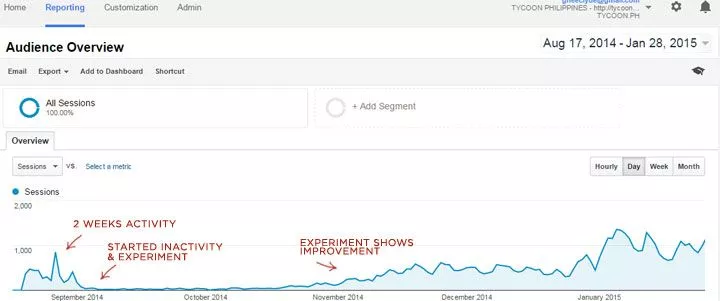
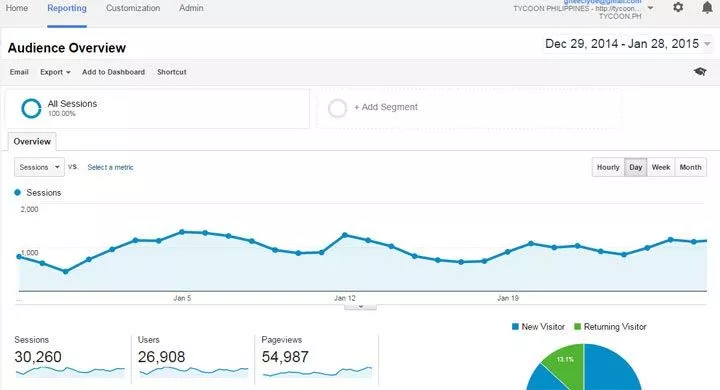
The new website, which started from scratch and was inactive for four months, is now receiving almost thousands of visitors per day. It has also generated leads, radio guesting, interview proposals, and advertising opportunities.
The site is now also included in the top blogs in business and finance in the Philippines. Moreover, it has also generated a minimum of $80 USD per month from Google AdSense.
Do you want to know how I did it?
Of course, you do, and I am more than pleased to show you the exact strategies and things I’ve done to make this possible. So, let’s get started.
Table of Contents
ToggleHow to Get 1,000 Website Visitors per Day
1. Configure website technicalities
The website was created through WordPress, and when I built it, four things were prioritized: website speed, meta tags, design, and site architecture.
Website Speed
Optimizing speed on a website is one of my favorites, and I usually do this with the help of a content delivery network (CDN). Optimizing website speed has been proven to increase the website traffic of other websites that I handled and tested.
CDN delivers webpages and other web content to a user based on his/her geographic location. I use MaxCDN, which is inexpensive and easy to integrate into WordPress websites.
I’ve also installed WordPress plug-ins, which are free, to increase website speed.
The following are the WordPress plug-ins that I’ve installed and used:
- Lazy Load
This plug-in loads images to improve page load times. It uses jQuery.sonar to load an image only when it’s visible in the viewport. Note: This plug-in doesn’t work on all themes, and it’s fine if you can’t use it.
- W3 Total Cache
You can easily add a CDN, such as MaxCDN, through W3 Total Cache. This plug-in improves the speed and user experience of your site.
- Use Google Libraries
This plug-in allows your WordPress site to use the content distribution network side of Google’s Ajax Library application program interface (API), instead of directly serving these files from your WordPress installation.
- WP Smush.it
This plug-in reduces image file sizes and improves performance by using its API within WordPress.
Meta Tags
Meta tags are snippets of code on a web page that provides structured metadata about a web page. I’ve written a long article about meta tags from my previous posts, which you can check here and here. I strongly recommend that you read them.
For all of my WordPress websites, I only choose one of the two plug-ins to help me configure the meta title, meta description, and social meta tags. These two plug-ins are All in One SEO Pack or WordPress Yoast. I’ve found out that some people use both, and it’s okay.
Design
I love beautiful designs, and I know that you love them, too. I choose and buy WordPress themes at ThemeForest, which I then customize.
During customization, although I’ve planned to serve ads from Google AdSense, I always make sure that the site will still look professional and beautiful in the eyes of my readers. To do this, I ask for feedback from some of my friends regarding the designs I’ve made.
Site Architecture
Site architecture is how a website is laid out and how the pages are interconnected with one another. According to him, site architecture has three criteria: technical, aesthetic, and functionality.
To keep the description simple and to give you an idea, I’ve described in the following how I structured Tycoon.ph site architecture for functionality so that my readers can easily navigate the website.
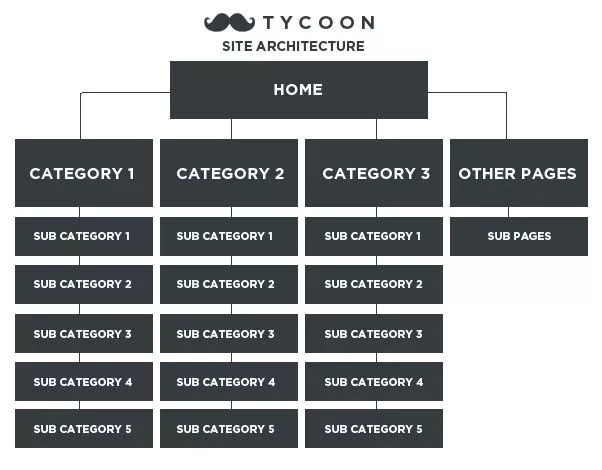
For Tycoon.ph, I had planned to use three main initial topics: business, marketing, and entrepreneurship. I made these three main topics as post categories. Each of these main categories has five subcategories.
I had to create articles that were related and based on those subcategories. Let’s take the subcategory “productivity” as an exampleofm the main category of “entrepreneurship.” However, before we even begin creating an article about this subcategory, you should follow the second step below.
2. Assess top-ranking articles on the search engine result page (SERP) for ideas
You need to follow these two steps so that the top-ranking articles on SERP can give you ideas for your content creation process:
- Simplify the keyword research process
- Generate topic ideas from SERP
Simplify the keyword research process
The first thing you may want to do is to go to Google Keyword Planner, which is free.
In this tool, you can search for the main keywords that you will use for your article topic or the keywords that you wish to rank on the search engines. To do this, simply type all the keywords, and then you should see a result like this:
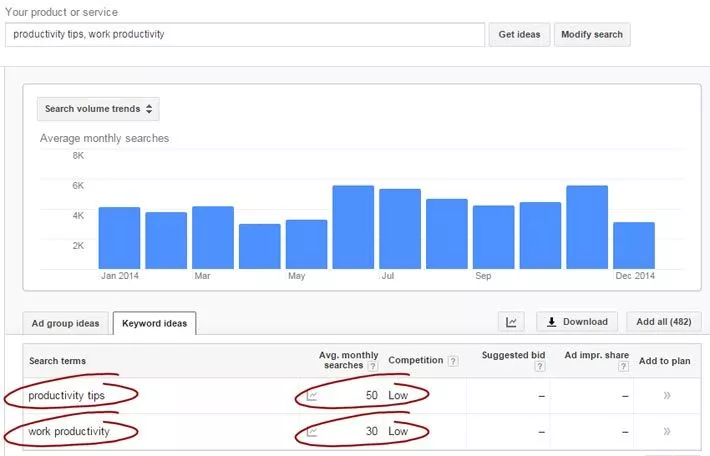
Since we are simplifying the process, the rule of thumb is simple: A keyword will remain a good investment for content production as long as there is a search count on it. You will still get rankings and searches from long-tail keywords anyway.
Generate topic ideas from SERP
In creating article topics, I’ve learned that few types of headlines stand out from the others, both on search engines and users. One of these types implies a “numbered list,” which is the easiest to create and outdo.
Here are a few examples of numbered-list posts:
- 10 Tips on How to Be Awesome
- 3,050 Digital Marketing Strategies that You’ll Love
- 100 Benefits of Coffee for Hardworking Entrepreneurs
- 5 Steps on How to Get 1,000 Visitors Per Day
You will notice that the first element on the title is a number.
Since we are trying to rank on SERP, we need to do a little Google search based on the simplified keyword research process. Here’s the result from the keyword “productivity tips”:
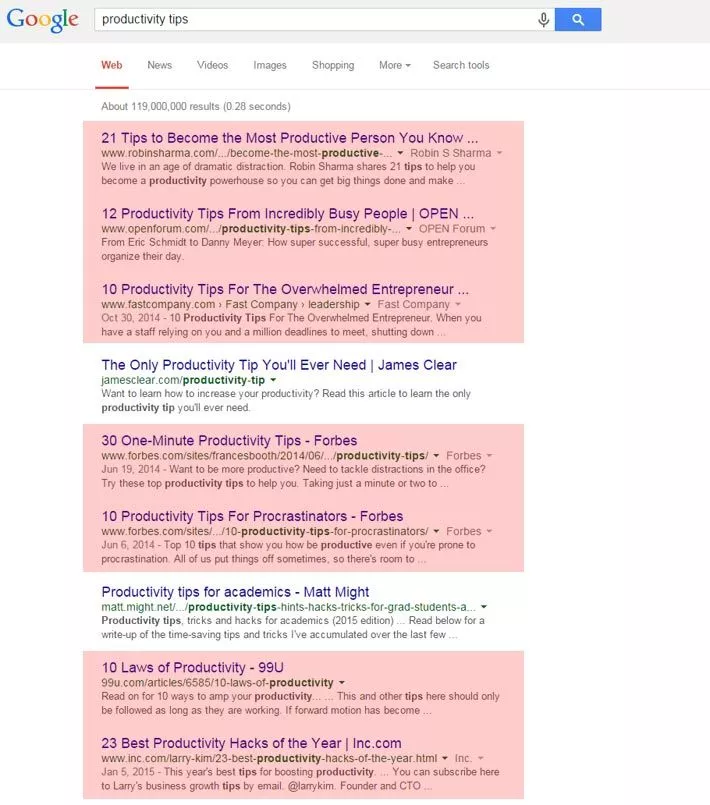
See? I’ve told you that numbered list posts rank well. We’ll then proceed to Step 3.
3. Produce better content
You need to produce content based on the research you have made from Step 2. Your content should outperform—both in quality and in quantity—the content that you’ve found.
There are different factors in measuring quantity and quality, but I’ll mention a few things that I consider important:
- Quantity – Total number of the list created and article length
- Quality – Flesch Reading Ease score, readability, grammatical error–free sentences, internal links, and external links
Outperform through Quantity
You should see from the result that we obtained by searching the keyword “productivity tips” that the highest tips generated are “30.” So in this case, if you want to compete with these already ranked articles, you should outperform them by providing more tips compared with the number of tips they have written and by presenting effective article length.
You may want to create 50, 70, or even 100 tips! You may also check the average length of their articles for comparison.
To give you an idea, the most recommended word count for articles that rank so well, which also worked for this experiment, is a minimum of 1,800.
Outperform through Quality
In addition to the originality or uniqueness of an article, that is, it shouldn’t be found anywhere else, the following are the things that you should keep in mind:
- The fonts and font sizes used in your website can affect readability.
- Having grammatical error–free sentences doesn’t equate to having a perfectly written article. In addition, the articles should be checked by an experienced editor. Alternatively, your users should at least easily understand your point.
- Make sure to link your past articles that are related to your current article. You may also want to link to other websites to support your idea and refer to related topics.
- Check your Flesch Reading Ease score or readability level, and make sure that it matches your readers’ grade level. I always aim for a Flesch Reading Ease score of 60% and above.
Once you are done creating the article, compare it to the high-ranking articles that you’ve seen from Step 2 and see if you outperformed them in terms of quality and quantity. You should also return to Step 1 and optimize the technicalities, particularly the meta tag.
4. Get Social
Since the website is new and I only have a limited time to manage the distribution process, I’ve decided to utilize the top-ranking social media website in my target country.
To determine this social media website, I went to Alexa and browsed the top sites in the Philippines. I’ve found out that Facebook is ranked as the number one most visited site in the Philippines. Thus, I’ve decided to choose it as the platform for sharing and building my audience.
Fortunately, Tycoon.ph managed to get 2,000 targeted likes in just two weeks!
Here are the steps on how I did this:
- Make the page simple and interesting through designs
- Invite your friends to like your page by using the Facebook page feature
- Invest $20 USD on Facebook ads to get an initial core audience
When the new article was ready for publishing, I simply scheduled its posting on the page based on the time my audience was online. You can easily determine the best time to post on your Facebook page by checking Facebook Insights.
To access Facebook Insights: Go to your Facebook Page > Click Insights > Click Posts.
I also ensured that I shared the new article on my profile so my friends would see it and probably share it, too.
5. Encourage contributions
Tycoon.ph has encouraged other people to submit unique articles in exchange for a link going back to their website, thereby improving their site’s SEO, that is, search engine optimization, and branding. But, it wasn’t the main reason why I did this.
Encouraging contributions not only helped my website obtain fresh and unique articles that can potentially rank on search engines but also enabled me to build relationships with blog contributors and receive free marketing services.
How? Whenever the article they submitted was approved and published, I notified them. Then, they shared this posting with their friends and audience, thereby making some of their active audience my audience.
Some lessons I’ve learned from this experiment
The preceding steps are the things I’ve done to generate thousands (and increase) of visitors with minimal effort, which are almost free. During this experiment, I’ve learned a few things:
- Consistent article posting doesn’t mean that you’ll get tons of visitors. Optimization, research, and distribution are the keys.
- You don’t need to complete all search engine ranking factors to get results and rank on search engines. Sometimes, minimal effort is enough as long as it is carefully planned and executed.
- Spending some money to get an initial core audience isn’t a negative move. It has been always helpful to build a large audience.
- Simplify, simplify, simplify.
- The “Give-to-receive” approach works.
So, there you go. I hope that you’ve found this post very useful since I spent more than four months delivering this to you.
Is your website or blog already getting 1,000 website visitors per day? If yes, how did you do it? Are there other steps, not mentioned above, that you’ve made? Let me know by following me on Twitter.
Last Updated on April 18, 2024
Subscribe And Receive Free Digital Marketing Tips To Grow Your Business
Join over 8,000+ people who receive free tips on digital marketing. Unsubscribe anytime.
Workroom is a digital marketing company in the Philippines. Our core services include logo design, website design and development, social media marketing and management, and search engine optimization.


